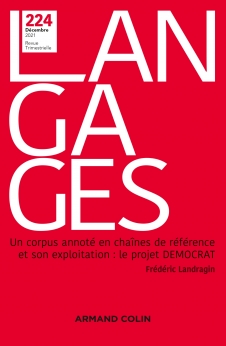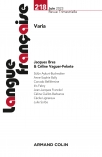
LANGAGES Nº 224 (4/2021)
Pour acheter ce numéro, contactez-nous
Recevez les numéros de l'année en cours et accédez à l'intégralité des articles en ligne.
La présente étude évalue le rôle des expressions coréférentielles dans la segmentation et la structuration des textes dans un corpus diachronique de textes narratifs annotés dans le cadre du projet DEMOCRAT. La structure textuelle varie : le découpage en paragraphes est systématique dans les textes modernes mais majoritairement absent dans les textes médiévaux. Notre étude montre que les chaînes de référence (CR) contribuent à délimiter la structure des textes anciens alors que, dans les textes modernes, les CR fonctionnent conjointement au découpage textuel. Au-delà de leur rôle dans des cas de concurrence référentielle, les redénominations participent au changement de structure par le mono-marquage ou le polymarquage. Le passage de l’un à l’autre semble conditionné par l’évolution de la forme et de l’écriture littéraire du Moyen Âge au XXe siècle.
This paper evaluates the role of co-referential expressions in the segmentation and structuring of texts in a diachronic corpus of narrative texts annotated within the framework of the DEMOCRAT project. The textual structures are different: paragraph division is ubiquitous in modern texts, but mostly absent from medieval texts. Our study shows that the chains of reference (CR) contribute to structure the ancient texts, whereas in modern texts, CR function with the division into paragraphs. Beyond their roles to disambiguate referential competition, we show that the redenominations catalyze a change in structure: they participate in two major types of marking, mono-marking or poly-marking. The passage from one to the other seems to be conditioned by the evolution of form and literary writing from the Middle Ages to the 20th century.
